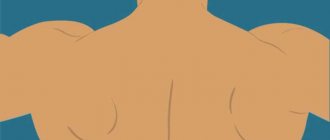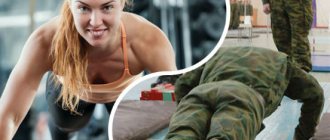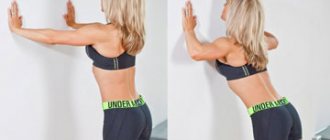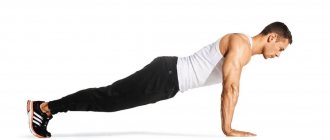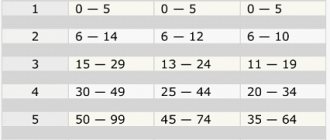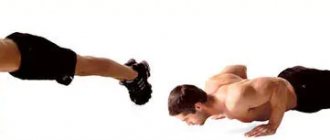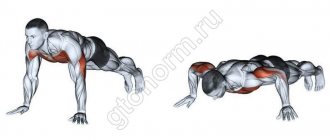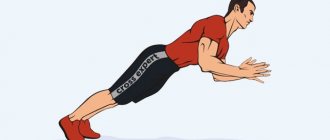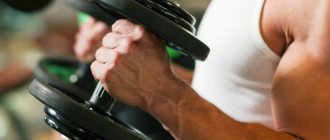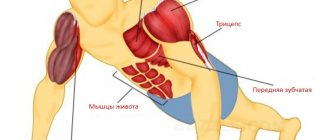A healthy lifestyle includes several aspects. This includes healthy eating, saturating the body with oxygen (long walks), constant social contacts, and regular exercise. It is sports exercises that help a person always be in good shape. Everyone determines their own “weak spots” on the body that need to be pumped up and trained. There are various exercises for this.
What is a push-up?
Any person who plays sports knows what a push-up is. This is a basic exercise that is done on the floor. It allows the person himself to regulate the work of various muscles. Doing this exercise is not at all difficult in terms of equipment, because it does not require any additional equipment, simulators or other equipment. Push-ups can be done both in the gym and at home, in the field, at sea, and so on.
During this exercise, the muscles of the chest, arms, and back work. When a person does push-ups, by shifting the emphasis to different parts of the body, he will be able to control the pumping of different muscle groups. Although this exercise is not too difficult, there are many ways to do it. This raises many questions. What are the benefits of fist push-ups? What's the best way to do push-ups? How to start doing this exercise? Are there any contraindications? We will try to answer all questions below.
Push-ups on fists or palms: how are they different?
An exercise to pump up the arms and chest in the classic version is done from the floor on the palms. It is used in almost all sports. At the same time, the chest muscles, anterior dalta muscles and triceps are actively worked and strengthened. Starting position of push-ups on the palms: arms are straight, shoulder-width apart from each other, legs are connected together, the body is fixed straight. Then the arms are bent, the chest touches the floor, they are straightened again. In this case, the entire body should always be in a straight position.
If this exercise works certain muscles so well, then what do push-ups with fists do? Why torture yourself and your fists if you can freely do an exercise on your palms? Pumping up of muscles occurs during classic push-ups and when performing them with fists. The second option is more suitable for power sports, since the fists themselves are more often used there.
Benefits of fist push-ups
We will find out what push-ups on fists give after we look at the main advantages of this type of exercise.
Such classes are conducted if necessary:
- train the striking surface;
- form the correct fist position;
- increase fortitude, since not everyone can perform this exercise;
- develop the skill of direct strikes by training the necessary muscles;
- secure the static hand upon impact;
- train, in addition to the muscles, the tendons of the hand.
How to do push-ups better with your fists
Push-ups on your fists have a number of undoubted advantages for a fighter over regular push-ups on your palms. This is, firstly, the opportunity to do push-ups more deeply and better work the chest and triceps, and secondly, this is done simultaneously with strengthening the striking knuckles.
The correct position of the fist when doing push-ups: the main load falls on the first two knuckles - the index and middle fingers; A common mistake is that the load is distributed on the last three dominoes, excluding the load on the first. Rarely does anyone succeed in standing clearly on the knuckles of the index and middle fingers, so be prepared that the knuckle of the ring finger will also become full.
Fists can be placed in three positions:
- parallel to the body,
- perpendicular to the body with thumbs inward
- perpendicular to the body with your thumbs outward (option with the greatest load on the biceps).
To begin with, it is better to start with push-ups on your fists from your knees or just stand on your fists for 1.5-2 minutes. Believe me, this is a very difficult exercise that will prepare your striking surfaces. If you start doing push-ups right away and with a decent number of repetitions, this can lead to damage to the skin, which has not yet been covered with a protective keratinized layer. This may be the end of fist push-ups for a while.
Starting position for push-ups
When you get into the desired position for push-ups, called the starting position, you can already feel the muscle tension. Beginners may not complete the task right away, but by trying to reach the floor more and more each time, they will achieve the desired minimum. You will see when doing push-ups with fists that they give much more than any other exercise for the arms. Strengthening of all body parts involved in the exercise is guaranteed from the first days of classes. To achieve the effect, proper placement and diligence will be required.
So, the lesson begins from the starting position: the fists are placed perpendicular to the entire body, the hands are located at a distance of shoulder width, the legs are together, the body and head are level. Fists are placed this way to train a classic strike in martial arts. The main emphasis is on the knuckles of two fingers: middle, index. The last fingers are less durable and can be damaged without preparation.
The choice of surface for the exercise is important. If you do not choose the right floor, push-ups on your fists can cause serious harm. For beginners, the emphasis should definitely be on a soft, elastic surface in order to train the joints and bones of the wrist. Only after a year or even two of constant training can you move on to a concrete, iron or wooden surface.
Those who have completed Sparta know that the fist stand is one of the first exercises that a training participant encounters on the first day. They also know that it is not the most athletic, muscular and hardy who stands on his fist longer than others, but the one who has a strong spirit and strong will.
This is a simple static exercise similar to a plank, which is simple in appearance, but in reality turns out to be quite uncomfortable.
If you decide to practice standing on your fist, then you will get the maximum benefit if you do it correctly.
Many athletes, training in the field of martial arts, practice push-ups with fists to set the force of the blow and strengthen the striking surfaces. For a fighter in this type of push-ups, it is important to strengthen the striking knuckles of the hands, so the main load falls on the first two knuckles - the index and middle fingers, but since rarely anyone succeeds in standing clearly on these knuckles, this issue is not fundamental for a fist stand.
The fists can be placed in three positions - parallel to the body, perpendicular to the body, thumbs in, and perpendicular to the body, thumbs out.
First practice standing on two fists - 1-2 minutes. It is better to start a one-fist stand from 1 minute, gradually increasing the time. Remember that first of all we train the will, so it is better to stand clearly for 1 minute than to wriggle, puff, groan and change body position for 5 minutes.
This static exercise strengthens your calves, thighs, buttocks, back, abs, chest, shoulders, forearms and neck. If you are a beginner, then most likely you will feel the load on your abs earlier than the load on your arms or bones. This means that your abs are rather weak and it would be nice to pump them up.
Before you start regular stopwatch training, test your limit. Once you get into a one- or two-fisted stance, remember that the goal is to stand for as long as possible. Ignore the pain and fatigue, stand as you would if you had a gun pointed at your head. The limit is when your body shakes and sweat literally pours out, and in the end you fall to the floor. After the fall, you will feel the incomparable pleasure that athletes love so much.
Now you know approximately the time from which you can start training. And in order for the exercise to bring maximum benefit, follow a few rules:
- Take the emphasis lying down, standing on your fists. Legs, back and head form a straight line. To do this, straighten your knees, do not arch your back and do not tilt your head.
- Once you have aligned your body, turn your body slightly and place one hand behind your back. The fist should be centered opposite the solar plexus.
- Keep your body straight, that's the most important thing. Don’t twitch, don’t shift your center of gravity - it won’t get any easier, but you’ll waste extra energy pretending to be a snake in a frying pan.
- Do not lift your pelvis while bending your knees. It is difficult to train your will and maintain a courageous appearance while in the “half-fork” position.
- A common mistake is to change hands. When you temporarily remove one hand and stand on the other, changing them to rest. This manipulation nullifies the entire result, so the best way out is to agree with yourself to train your other hand the next day.
If it’s hard for you.
At the initial stage, stand not on your fists, but on your palms. This will relieve tension in your hands and forearms, and will also make standing on a hard surface less painful.
Alternatively, stand in a plank position. This exercise differs in its starting position - you stand on your forearms, bending your elbows. This will also take the strain off your hands and make the task easier.
As soon as you feel that you are stronger, move on to a fist stand.
If it's easy for you
Let’s say you’re persistent, you’ve been training for 3-4 months and stand on your fist for 15-20 minutes. Standing further is simply boring, so the exercise can be complicated.
To do this, simply raise your legs higher. Place them on some elevated surface: a chair, a bed, a nightstand, a stack of books. This will increase the load on the core muscles.
Exercise every day, and if you are not yet ready for such loads, then at least every other day. And remember - quality is more important than duration.
By the way, after this exercise your head becomes so empty that we highly recommend that you start meditating right away. This is the best time for practice – it has been tested by more than a dozen “Spartans”.
Exercise technique
To train your fists and pump up the muscles of your arms and chest, you need to follow certain push-up rules. They very often overlap with the requirements for the exercise, which is performed on the palms, but there are still some peculiarities in how to perform push-ups on the fists. The technique consists of strictly following several points.
- Hands should be located at a small distance from each other.
- The thumbs of the fists should be directed towards each other inside.
- It is important to lower yourself, almost touching the floor, this gives maximum load on all the muscles involved in the exercise.
- It is best to start the exercise in the lower position of the body (at the base). In this position of the body, it is easier to jerk up and then lower down. This method brings the exercise as close as possible to a combat situation, when the arms are bent: they hit, then bent again. But this approach is not necessary; you can start in the upper body position.
- To make it more convenient and also more effective, you can put one leg behind the other.
- Since this exercise trains readiness for battle, the limit of training will be a state in which it is impossible to do sharp push-ups. Slow push-ups with force will not work here; in this case, it is better to finish it.
Exercise technique
In fact, most of the aspects characteristic of regular push-ups also work in this case. Place your fists on the floor correctly. You need to rely specifically on the striking surface, that is, on the index and middle finger. The innominate may also be partially involved - it all depends on the structure of the hand.
Impact surface of the fist.
So, how to do push-ups on the floor with your fists:
- Starting position – lying on the floor. You can rest your toes against the wall to prevent slipping. Place your fists on both sides of the body parallel or perpendicular to the body.
- As you exhale, forcefully push yourself upward. The body is absolutely straight and in line with the legs, the abdominal muscles are tense.
- As you inhale, gently lower yourself almost to the floor. There should be about five centimeters between its surface and the chest.
The number of repetitions and approaches per exercise depends on your goals. When training for endurance, to strengthen ligaments and joints, do the maximum possible number of repetitions in 3-4 approaches.
If you want to achieve maximum muscle growth, it is better to use push-ups not on your fists, but on your palms with additional weights. Or, as an option, raise your feet from the floor to the bench. But this option can only be used by experienced athletes with trained ligaments and joints. The number of repetitions in this case is reduced to 8–12.
Depending on the turn of the hand and the width of the grip, you can use certain muscles to the greatest extent:
- With the fists in a parallel position, when the thumbs are pointed forward and the elbows are pressed to the sides during movement, the emphasis of the load falls on the triceps or triceps brachii muscles.
- When you use a wide grip and place your fists with your thumbs inward (this corresponds to a straight punch), your elbows move out to the sides, working mainly the pectoral muscles. At the lowest point you should feel them stretching.
- By turning your thumbs outward, you will force your biceps to work.
The benefits of the exercise will be maximum if you periodically alternate the position of your hands.
If the goal of your workout is to develop specifically the pectoral muscles, you can try push-ups on special supports. They also increase the range of motion, but the hands are less loaded.
